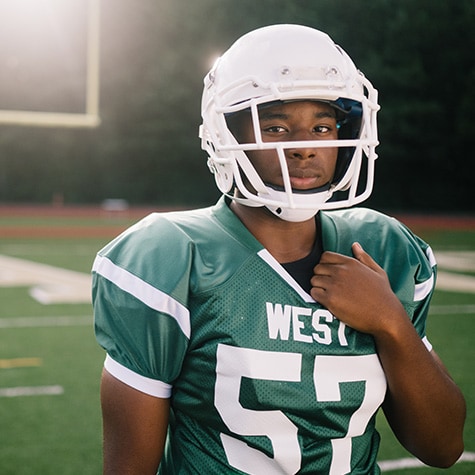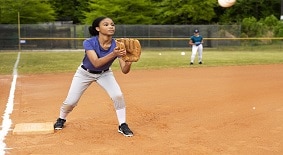How to Keep Your Teen Athlete Safe From the Cold
Updated 4/5/21
Cold-weather injuries are dangerous and preventable. When your teen athlete takes the field for cold-weather sports and sporting events during the winter months, she needs to take care to stay safe and healthy.
In cold weather, bodies lose heat faster than they can produce it, which can lead to serious health problems like hypothermia or frostbite. Teen athletes who participate in (or attend) cold-weather sports may be at risk for these and other cold-related illnesses or injuries.

“Being properly prepared for the elements is key to preventing cold-weather illness and injury,” says Tiffany Swales, a Pediatric Athletic Trainer and Supervisor at Children’s Healthcare of Atlanta. “While anyone practicing or competing in cold temperatures is at risk for cold-related illness and injury, there are some groups who need to be particularly careful out in the elements,” says Tiffany. “Young athletes are at greater risk for cold-weather injuries because they are genetically predisposed. Extra precautions should be taken by these athletes when playing outdoors.”
When it comes to playing and competing in the cold, growing athletes should:
- Be aware of current and forecasted weather before going outside.
- Wear layers to make it easy to remove or add clothing as conditions and exertion levels change. However, be careful not to wear too many layers, as they may cause overheating and excess sweating.
- Wear technical fabrics that wick moisture and sweat, which can help your teen stay dry, close to the body. Staying dry means staying warm—and it may be hard for your teen to get warm again once wet. A middle layer of fleece or natural fibers can provide insulation, and water- and wind-resistance outer layers can help reduce loss of body heat and protect your athlete from the elements.
- Stay hydrated with water or a sports drink.
- Maintain a well-balanced diet. (Check out these breakfast and lunch ideas to fuel your athlete.)
- Bring extra shoes, socks, clothes and gloves to replace any item that becomes wet.
Whether your growing athlete is bundling up for practice or for competition, it’s important to know the signs of these common cold-weather injuries.
Hypothermia
Hypothermia is a serious concern for athletes in cold temperatures. Hypothermia usually occurs when it’s very cold outside, but it can also strike when temperatures are merely cool and an athlete gets wet or sweaty and then becomes chilled.
What are signs of hypothermia in kids and teens?
- Shivering
- Exhaustion
- Confusion
- Drowsiness
- Slurred speech
- Fumbling hands
- Memory loss
Frostbite
While it’s unlikely that your teen athlete will develop frostbite in Georgia, it's something to be mindful of. Frostbite is a risk if your child is playing in temperatures under 32 degrees and has skin exposed. It can lead to a loss of feeling and color in affected areas—usually the nose, ears, cheeks, chin, fingers or toes. Frostbite can permanently damage the body and, in severe cases, can lead to amputation.
What signs of frostbite should you look out for?
- Redness, pain or numbness
- White or grayish-yellow skin
- Unusually firm or waxy-feeling skin
- Numbness
What should you do when an athlete shows signs of hypothermia or frostbite?
- Move the athlete to a warm room or shelter.
- Remove any wet clothing.
- Warm the athlete up under layers of dry blankets or clothing.
- Seek medical attention.
Chilblains
Extended exposure to cold, wet conditions can lead to itchy and swollen red patches of skin known as chilblains. These spots or blisters usually clear up in a matter of weeks—especially if the weather is warming.
How can young athletes prevent chilblains?
- Dress in layers of loose-fitting clothing.
- Limit the amount of skin that is exposed to the elements. Gloves, gaiters and face coverings can help.
What should you do when your child develops chilblains?
Chilblains should go away on their own. However, it’s important that your child heed the following DON’TS:
- Do not put hands or feet under hot water or near a heater, causing a drastic change in temperature.
- Do not massage or put lotions or creams on the affected area.
Remember, these cold-weather injuries can be serious, and it’s important for parents and coaches to do their part in knowing these signs and being properly prepared.
Keeping Young Athletes Safe Year-Round

We are exclusively dedicated to kids and teen athletes.
The Sports Medicine Program at Children’s is one of the only programs in the country dedicated exclusively to caring for growing athletes. Our team is specially trained to care for teen athletes with sports-related injuries and illnesses.
Learn MoreThis article has been clinically reviewed by Tiffany Swales, MS, LAT, ATC, a Certified Athletic Trainer and Supervisor at Children’s Healthcare of Atlanta.
This content is general information and is not specific medical advice. Always consult with a doctor or healthcare provider if you have any questions or concerns about the health of a child. In case of an urgent concern or emergency, call 911 or go to the nearest emergency department right away. Some physicians and affiliated healthcare professionals on the Children’s Healthcare of Atlanta team are independent providers and are not our employees.
Contact Us 404-785-KIDS (5437)



